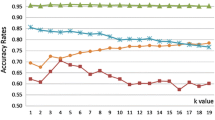Abstract
The performance of the k Nearest Neighbor (kNN) algorithm depends critically on its being given a good metric over the input space. One of its main drawbacks is that kNN uses only the geometric distance to measure the similarity and the dissimilarity between the objects without using any statistical regularities in the data, which could help convey the inter-class distance. We found that objects belonging to the same cluster usually share some common traits even though their geometric distance might be large. We therefore decided to define a metric based on clustering. As there is no optimal clustering algorithm with optimal parameter values, several clustering runs are performed yielding an ensemble of clustering (EC) results. The distance between points is defined by how many times the objects were not clustered together. This distance is then used within the framework of the kNN algorithm (kNN-EC). Moreover, objects which were always clustered together in the same clusters are defined as members of an equivalence class. As a result the algorithm now runs on equivalence classes instead of single objects. In our experiments the number of equivalence classes is usually one tenth to one fourth of the number of objects. This equivalence class representation is in effect a smart data reduction technique which can have a wide range of applications. It is complementary to other data reduction methods such as feature selection and methods for dimensionality reduction such as for example PCA. We compared kNN-EC to the original kNN on standard datasets from different fields, and for segmenting a real color image to foreground and background. Our experiments show that kNN-EC performs better than or comparable to the original kNN over the standard datasets and is superior for the color image segmentation.
Access this chapter
Tax calculation will be finalised at checkout
Purchases are for personal use only
Preview
Unable to display preview. Download preview PDF.
Similar content being viewed by others
References
Belkin, M., Niyogi, P.: Laplacian eigenmaps for dimensionality reduction and data representation. Neural Computation 15(6), 1373–1396 (2003)
Bias, L.: Variance and arcing classifiers. Tec. Report 460, Statistics department (1996)
Chabrier, S., Emile, B., Rosenberger, C., Laurent, H.: Unsupervised performance evaluation of image segmentation. EURASIP Journal on Applied Signal Processing, 1–12 (2006)
Chang, C.-C., Lin, C.-J.: LIBSVM: A library for support vector machines. ACM Transactions on Intelligent Systems and Technology 2, 27:1–27:27 (2011), Software, http://www.csie.ntu.edu.tw/~cjlin/libsvm
Chopra, S., Hadsell, R., LeCun, Y.: Learning a similarity metric discriminatively, with application to face verification. In: IEEE Conf. on Computer Vision and Pattern Recognition, pp. 26–33 (2005)
Christoudias, C., Georgescu, B., Meer, P.: Synergism in low level vision. In: Proceedings of International Conference on Pattern Recognition, pp. 150–155 (2002)
Comaniciu, D., Meer, P.: Mean shift: A robust approach toward feature space analysis. IEEE Transactions on Pattern Analysis and Machine Intelligence 24(5), 603–619 (2002)
Cover, T., Hart, P.: Nearest neighbor pattern classification. IEEE Transactions on Information Theory 13(1), 21–27 (1967)
Derbeko, P., El-Yaniv, R., Meir, R.: Explicit learning curves for transduction and application to clustering and compression algorithms. Journal of Artificial Intelligence Research 22(1), 117–142 (2004)
Domeniconi, C., Gunopulos, D., Peng, J.: Large margin nearest neighbor classifiers. IEEE Transactions on Neural Networks 16(4), 899–909 (2005)
Fern, X.Z., Brodley, C.E.: Solving cluster ensemble problems by bipartite graph partitioning. In: Proceedings of the Twenty-First International Conference on Machine Learning, pp. 36–43. ACM (2004)
Frank, A., Asuncion, A.: UCI machine learning repository (2010)
Georgescu, B., Shimshoni, I., Meer, P.: Mean shift based clustering in high dimensions: A texture classification example. In: Proceedings of the 9th International Conference on Computer Vision, pp. 456–463 (2003)
Goldberger, J., Roweis, S., Hinton, G., Salakhutdinov, R.: Neighbourhood components analysis. In: Advances in Neural Information Processing Systems, vol. 17, pp. 513–520 (2004)
Gonzalez, R.C., Woods, R.E.: Digital Image Processing, 2nd edn. Addison-Wesley Longman Publishing Co., Inc., Boston (2001)
Hastie, T., Tibshirani, R.: Discriminant adaptive nearest neighbor classification. IEEE Transactions on Pattern Analysis and Machine Intelligence 18(6), 607–616 (1996)
Lindenbaum, M., Markovitch, S., Rusakov, D.: Selective sampling for nearest neighbor classifiers. Machine Learning 54(2), 125–152 (2004)
MacQueen, J.B.: Some methods for classification and analysis of multivariate observations. In: Proceedings of the Fifth Symposium on Math., Statistics, and Probability, pp. 281–297 (1967)
Min, J., Powell, M., Bowyer, K.W.: Automated performance evaluation of range image segmentation algorithms. IEEE Transactions on Systems Man and Cybernetics-Part B-Cybernetics 34(1), 263–271 (2004)
Rand, W.M.: Objective criteria for the evaluation of clustering methods. Journal of the American Statistical Association 66, 846–850 (1971)
Saul, L.K., Roweis, S.T.: Think globally, fit locally: unsupervised learning of low dimensional manifolds. The Journal of Machine Learning Research 4, 119–155 (2003)
Shalev-Shwartz, S., Singer, Y., Ng, A.Y.: Online and batch learning of pseudo-metrics. In: Proceedings of the Twenty-First International Conference on Machine Learning, pp. 94–102. ACM (2004)
Tenenbaum, J.B., Silva, V., Langford, J.C.: A global geometric framework for nonlinear dimensionality reduction. Science 290(5500), 19–23 (2000)
Weinberger, K.Q., Saul, L.K.: Distance metric learning for large margin nearest neighbor classification. The Journal of Machine Learning Research 10, 207–244 (2009)
Zhang, H., Fritts, J.E., Goldman, S.A.: Image segmentation evaluation: A survey of unsupervised methods. Computer Vision and Image Understanding 110(2), 260–280 (2008)
Author information
Authors and Affiliations
Editor information
Editors and Affiliations
Rights and permissions
Copyright information
© 2012 Springer-Verlag Berlin Heidelberg
About this paper
Cite this paper
AbedAllah, L., Shimshoni, I. (2012). k Nearest Neighbor Using Ensemble Clustering. In: Cuzzocrea, A., Dayal, U. (eds) Data Warehousing and Knowledge Discovery. DaWaK 2012. Lecture Notes in Computer Science, vol 7448. Springer, Berlin, Heidelberg. https://doi.org/10.1007/978-3-642-32584-7_22
Download citation
DOI: https://doi.org/10.1007/978-3-642-32584-7_22
Publisher Name: Springer, Berlin, Heidelberg
Print ISBN: 978-3-642-32583-0
Online ISBN: 978-3-642-32584-7
eBook Packages: Computer ScienceComputer Science (R0)




